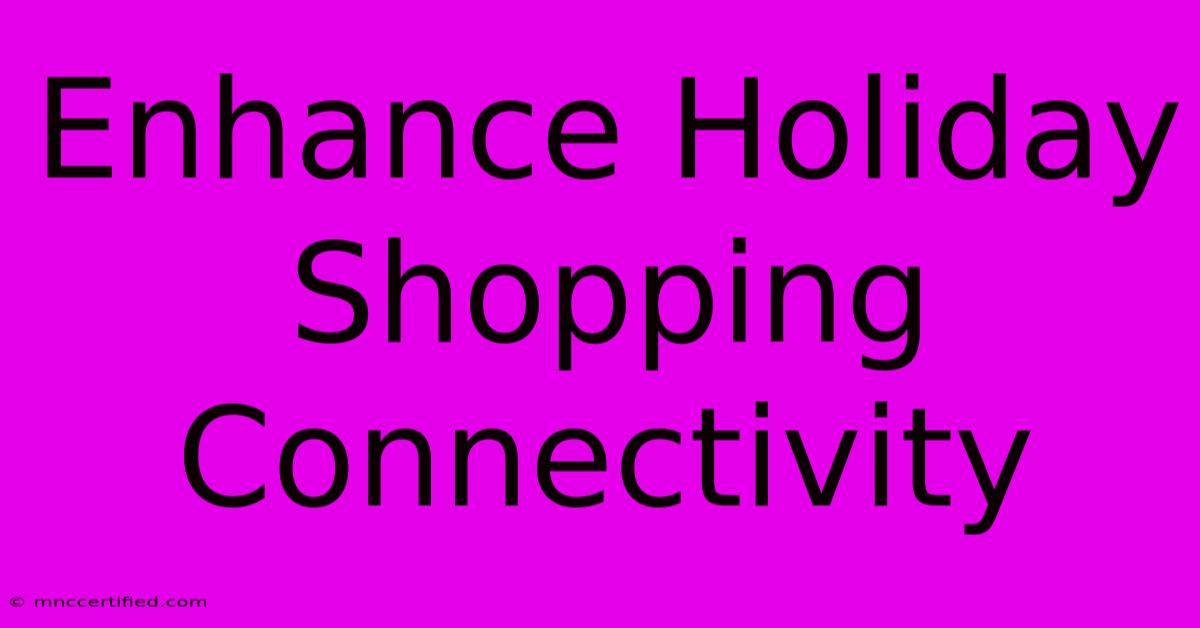Enhance Holiday Shopping Connectivity

Table of Contents
Enhance Holiday Shopping Connectivity: A Guide to Seamless Online and Offline Experiences
The holiday shopping season is a whirlwind of excitement, deals, and… potential connectivity issues. For both shoppers and retailers, a seamless online and offline experience is crucial for success. This article explores strategies to enhance holiday shopping connectivity, ensuring a smooth and enjoyable experience for everyone.
Understanding the Connectivity Challenge
The holiday season puts immense strain on retail infrastructure. Websites crash under the weight of high traffic, shipping logistics become congested, and communication channels get overloaded. This results in frustrated shoppers, lost sales, and damaged brand reputation. Therefore, proactively enhancing connectivity across all touchpoints is paramount.
Key Connectivity Aspects to Address:
- Website Performance: Slow loading speeds and website crashes are major turn-offs. Ensure your website can handle peak traffic. Consider investing in robust hosting and employing content delivery networks (CDNs).
- Mobile Optimization: A significant portion of holiday shopping happens on mobile devices. Your website must be responsive and user-friendly on all screen sizes.
- E-commerce Platform Integration: Seamless integration between your website, payment gateway, and inventory management system is essential to prevent order processing delays and errors.
- Customer Service Channels: Provide multiple customer service channels (e.g., live chat, email, phone) and ensure quick response times. Proactive communication during peak periods is vital.
- Shipping and Logistics: Partner with reliable shipping carriers and provide accurate delivery estimates. Transparent communication about shipping updates builds trust.
- Offline Connectivity (Brick-and-Mortar Stores): Ensure reliable Wi-Fi and POS systems are in place to facilitate in-store purchases and smooth customer transactions.
Strategies to Enhance Holiday Shopping Connectivity
1. Optimize Website Infrastructure:
- Load Testing: Conduct thorough load tests to identify and address potential bottlenecks before the holiday rush.
- CDN Implementation: A CDN distributes your website's content across multiple servers globally, ensuring faster loading times for users regardless of their location.
- Caching Strategies: Implement effective caching mechanisms to reduce server load and improve response times.
- Database Optimization: Ensure your database is optimized for efficient data retrieval, reducing query times.
2. Improve Customer Service Capabilities:
- Proactive Communication: Send automated emails acknowledging orders, providing shipping updates, and addressing potential delays.
- Multiple Support Channels: Offer live chat, email, phone, and social media support to cater to diverse customer preferences.
- Self-Service Resources: Provide a comprehensive FAQ section and helpful articles to address common customer queries.
- Invest in Customer Support Software: Utilize tools for efficient ticket management and tracking to reduce response times.
3. Streamline Order Fulfillment:
- Inventory Management: Accurate inventory tracking is crucial to avoid overselling and stockouts.
- Efficient Order Processing: Automate order processing workflows to minimize manual intervention and errors.
- Strategic Partnerships: Collaborate with reliable shipping carriers and logistics providers to ensure timely delivery.
- Real-time Tracking: Provide customers with real-time tracking information for their orders, increasing transparency and satisfaction.
4. Enhance Offline Connectivity:
- Reliable Wi-Fi: Ensure strong and reliable Wi-Fi in your brick-and-mortar stores to facilitate in-store purchases and customer engagement.
- Robust POS Systems: Invest in reliable point-of-sale systems that can handle high transaction volumes during peak periods.
- Mobile POS (mPOS): Consider using mobile POS systems to enhance flexibility and improve customer service in areas with high foot traffic.
Measuring Success and Continuous Improvement
Monitoring key metrics is crucial to assess the effectiveness of your connectivity enhancement strategies. Track metrics like website load times, customer satisfaction scores, order fulfillment rates, and average response times. Regularly analyze these metrics and adapt your strategies to optimize performance continuously.
By implementing these strategies, retailers can significantly enhance holiday shopping connectivity, leading to improved customer experiences, increased sales, and a stronger brand reputation. The focus should always be on providing a seamless and enjoyable shopping journey, regardless of the channel used. Remember, a satisfied customer is a returning customer, especially during the competitive holiday shopping season.

Thank you for visiting our website wich cover about Enhance Holiday Shopping Connectivity. We hope the information provided has been useful to you. Feel free to contact us if you have any questions or need further assistance. See you next time and dont miss to bookmark.
Featured Posts
-
Foster And Sullivan Insurance
Nov 29, 2024
-
Chiefs Raiders 2024 Spread Line Time
Nov 29, 2024
-
Thanksgiving Nbc Remembers John Madden
Nov 29, 2024
-
Vantis Life Insurance Reviews
Nov 29, 2024
-
Fisher Investments Costa Rica
Nov 29, 2024